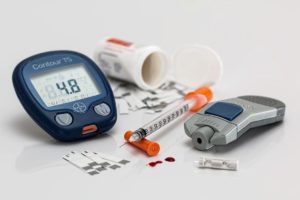Table of Contents
 Glucometers are hand-held monitoring devices that detect the blood glucose level and are used by people who have diabetes for self-monitoring. It is a simple way to track your blood sugar level in between the visits to the doctor and judge whether you are following the right lifestyle habits.
Glucometers are hand-held monitoring devices that detect the blood glucose level and are used by people who have diabetes for self-monitoring. It is a simple way to track your blood sugar level in between the visits to the doctor and judge whether you are following the right lifestyle habits.
So if you are just detected with diabetes and have been suggested a glucometer by your physician, then this article is for you. Here, an attempt is made to give you the vital information about purchasing the glucometer, how to take care of it so that it displays accurate results as well as the right usage of this instrument.
Tips for Purchasing the Perfect Glucometer
These are some tips for purchasing the perfect glucometer so that you can keep a close eye on your blood glucose level right at your home.
- A glucometer that arrives with the attached strip drum or disk is simpler to handle.
- You can go for the glucometer that comes with “voice reading” feature if you have vision problems. You can hear the results then. You can also opt for the ones with backlight. This will help you to check the reading at night if you have problems with your vision.
- The display of the device that you buy should be easy to read. Do not go for the ones that are very complicated to use and are quite high-tech.
- Check how the glucometer is able to store the results for you and check how conveniently you can download them. Today, you can also get glucometers that help you to mail the results to your doctor after downloading the results.
- Avoid the tools where you have to enter a unique key or a code each time you need to alter the test strip. This is something that will result in more hassles for you, especially at the times of emergencies.
How to Take Care of Your Glucometer
Here are some of the tips that will help you to take care of your glucometer in the right way. If you do not take good care of your glucometer then it may display wrong results that can wreak havoc on your health.
- You should make it a point to keep the lid of your strips container always closed tightly. This happens because moisture damages the proper functioning of these strips.
- Every once in a while, make it a point to calibrate the glucometer. Regular calibration is a must to remove any error or margin and to ensure that your glucometer is working accurately.
- Regular cleaning of your glucometer is a must. You should also ensure that you keep it in the case always for protecting it from moisture.
How Many Times You Should Use the Glucometer
The type of diabetes you have determines the number of times you need to use the glucometer. In Type 1 diabetic patients, the blood sugar level tends to fluctuate more than that of Type 2 diabetic patients. Therefore they need to check more often. To adjust their insulin dosage Type 1 diabetes patients go for glucometer testing 3 to 4 times a day.
On the basis of the case, Type 2 diabetic patients can check from once or twice a day to about once or twice a week.
The glucometer testing offers different information on the basis of the time of the day that you take the test in. For example –
- Testing after lunch or breakfast will tell you if your morning dosage of medicine is adequate
- Similarly, fasting blood sugar will show whether the night dosage of medicine was taken in the right amount.
Your doctor can adjust your medicine based on these.
Related:
Mistakes While Using a Glucometer
A problem that is quite common with diabetics using glucometers is that they often get paranoid and they end up using their glucometers more often than recommended. Frequent testing leads to pointless worries among the patients regarding their blood sugar level being too high or too low. That is why you should always follow the timeline suggested by your doctor.
Secondly, keep it in mind that there is no point conducting the glucometer test if you do not know what to do after you get the results. So consult with your doctor how to analyze the results and the further course of actions to be taken after it.



